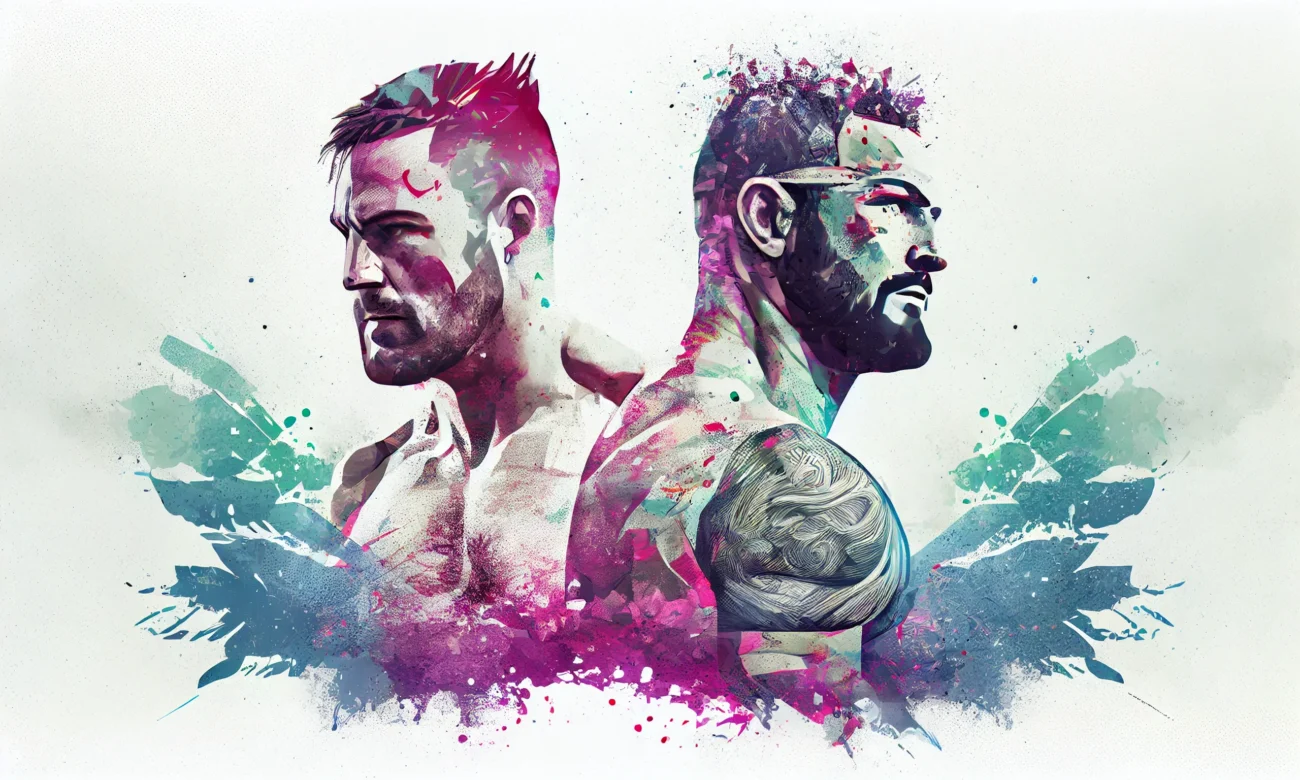Like all martial arts and combat sports, the UFC has several weight categories called divisions. In mixed martial arts, a weight class is a competition division that matches fighters against each other at their size.
As we know, the primary purpose of weight categories is to equalize the battlefield and enable relatively similar opponents to face each other without anyone having a clear-cut advantage over the other.
You can see MMA (and UFC weight classes or divisions) below:
- Atomweight 105 lbs (47.6 kg);
- Strawweight 115 lb (52.2 kg) – UFC female;
- Flyweight 125 lb (56.7 kg) – UFC female/male;
- Bantamweight 135 lb (61.2 kg) – UFC female/male;
- Featherweight 145 lb (65.8 kg) – UFC female/male;
- Lightweight: 155 lb (70.3 kg) – UFC male;
- Super lightweight 165 lb (74.8 kg);
- Welterweight 170 lb (77.1 kg) – UFC male;
- Super welterweight 175 lb (79.4 kg);
- Middleweight 185 lb (83.9 kg) – UFC male;
- Super middleweight 195 lb (88.5 kg);
- Light heavyweight 205 lb (93.0 kg) – UFC male;
- Cruiserweight 225 lb (102.1 kg);
- Heavyweight 265 lb (120.2 kg) – UFC male;
- Super heavyweight – No limit.
In this article, I will present to you the UFC weight divisions, as well as all the champions for each of them. There are not many – 8 for men and 4 for women – but that does not make it less attractive.
How Many UFC Weight Classes Are There?
To understand the UFC weight divisions, we must understand how MMA’s weight divisions and categories work. Since it would be of no use for us to describe all the categories, I shall present them to you in one table, which is pretty self-explanatory:
| Weight Class | Maximum Weight |
|---|---|
| Strawweight | 115 lbs (52.2 kg) |
| Flyweight | 125 lbs (56.7 kg) |
| Bantamweight | 135 lbs (61.2 kg) |
| Featherweight | 145 lbs (65.8 kg) |
| Lightweight | 155 lbs (70.3 kg) |
| Super Lightweight | 165 lbs (74.8 kg) |
| Welterweight | 170 lbs (77.1 kg) |
| Super Welterweight | 175 lbs (79.4 kg) |
| Middleweight | 185 lbs (83.9 kg) |
| Super Middleweight | 195 lbs (88.5 kg) |
| Light Heavyweight | 205 lbs (93 kg) |
| Cruiserweight | 225 lbs (102.1 kg) |
| Heavyweight | 265 lbs (120.2 kg) |
| Super Heavyweight | None |
Why Do UFC Weight Classes Exist?
The primary purpose of UFC weight classes is to equalize the playing field and enable relatively similar opponents to face each other without having a clear-cut advantage.
When Did The UFC Get Weight Classes?
UFC weight classes were first introduced in 1997. At UFC 12, the first two UFC weight classes were introduced, UFC lightweight division and UFC heavyweight division. At UFC 31, the weight classes were modified to reflect the current MMA standard.
UFC Men’s Weight Classes (Divisions)
As you will soon see, the UFC doesn’t have a division for each weight class category, as presented in the table.
The UFC only has eight divisions, corresponding to eight of the before-mentioned categories.
The oldest one is the Heavyweight Division, founded back in 1997.
The Light Heavyweight and Welterweight Divisions soon followed in December 1997 and 1998, respectively, with the Lightweight and Middleweight divisions being introduced in 2001.
The most recent divisions were the Bantamweight and Featherweight, introduced in 2010, and the Flyweight Division, introduced in 2012.
So, historically, the first-ever weight division UFC champion was Mark Coleman, who won the Heavyweight belt in 1997.
UFC Women’s Weight Classes (Divisions)
The competition format for women is both newer in date and a lot smaller. Women only participate in four categories, with three being the same as men and one specifically for women.
The oldest among them is the Women’s Bantamweight Division, which got its first champion at the end of 2012.
The end of 2014 saw the establishment of the Women’s Strawweight Division, while the remaining two divisions – Women’s Featherweight and Women’s Flyweight division – started in 2017.
So, the first female UFC champion in any category was American Ronda Rousey, who won the Women’s Bantamweight title in December 2012.

UFC Tournaments and the Superfight Championship
Throughout its existence, the UFC has also held numerous openweight tournaments.
Unlike the more-known divisions, openweight tournaments do not have any weight limits, which means that everyone can participate and that there can be a substantial difference in the physique of the fighters, something we’ve discussed at the beginning of this article.
Indeed, that could lead to unfair situations, but if you know the rules beforehand and accept them, the issue is a bit clearer.
UFC has had two openweight competitions, with just one being active. The now-defunct Superfight Championship was held only twice, in 1995 and 1996, and was envisioned as a tournament determining the ultimate UFC champion.
Ken Shamrock won the first edition, while his challenger from 1995, Dan Severn, became the tournament’s king and final winner.
The UFC tournaments have been held irregularly since 1999 (until then, they had an annual event, sometimes held more than once a year), from which moment only two tournaments were held – one in 2003 and the most recent in 2012.
These tournaments were initially openweight but have been associated with weight divisions since the UFC 12 edition in 1997.
Of course, I will bring you a list of all of them and the winners in the table below:
| Tournament | Date | Division | Winner |
|---|---|---|---|
| UFC 1 | November 12, 1993 | None | Royce Gracie (BRA) |
| UFC 2 | March 11, 1994 | None | Royce Gracie (BRA) |
| UFC 3 | September 9, 1994 | None | Steve Jennum (USA) |
| UFC 4 | December 16, 1994 | None | Royce Gracie (BRA) |
| UFC 5 | April 7, 1995 | None | Dan Severn (USA) |
| UFC 6 | July 14, 1995 | None | Oleg Taktarov (RUS) |
| UFC 7 | September 8, 1995 | None | Marco Ruas (BRA) |
| The Ultimate Ultimate | December 16, 1995 | None | Dan Severn (USA) |
| UFC 8 | February 16, 1996 | None | Don Frye (USA) |
| UFC 10 | July 20, 1996 | None | Mark Coleman (USA) |
| UFC 11 | September 20, 1996 | None | Mark Coleman (USA) |
| The Ultimate Ultimate 2 | December 7, 1996 | None | Don Fyre (USA) |
| UFC 12 | February 7, 1997 | Heavyweight | Vitor Belfort (BRA) |
| UFC 12 | February 7, 1997 | Lightweight | Jerry Bohlander (USA) |
| UFC 13 | May 30, 1997 | Heavyweight | Randy Couture (USA) |
| UFC 13 | May 30, 1997 | Lightweight | Guy Mezger (USA) |
| UFC 14 | July 27, 1997 | Heavyweight | Mark Kerr (USA) |
| UFC 14 | July 27, 1997 | Lightweight | Kevin Jackson (USA) |
| UFC 15 | October 17, 1997 | Heavyweight | Mark Kerr (USA) |
| Ultimate Japan | December 21, 1997 | Heavyweight | Kazushi Sakuraba (JAP) |
| UFC 16 | March 13, 1998 | Lightweight | Pat Miletich (USA) |
| UFC 17 | May 15, 1998 | Middleweight | Dan Henderson (USA) |
| UFC 23 | November 19, 1999 | Middleweight | Kenichi Yamamoto (JAP) |
| UFC 39 | February 28, 2003 | Lightweight | BJ Penn (USA) / Caol Uno (JAP) – draw |
| UFC 41 | February 28, 2003 | Lightweight | BJ Penn (USA) / Caol Uno (JAP) – draw |
| UFC on FX | September 22, 2012 | Flyweight | Demetrious Johnson (USA) |
| UFC on FX 2 | September 22, 2012 | Flyweight | Demetrious Johnson (USA) |
| UFC 152 | September 22, 2012 | Flyweight | Demetrious Johnson (USA) |
What Is the Weigh-In Policy in UFC?
Neither fighter must weigh more than the upper limit of their respective division at the weigh-ins.
For non-title bouts, you can come in one pound heavier at the weigh-ins. This mostly happens in fight night events, where the Octagon warriors mostly compete in the bouts where the belt is not on the line.
When the division strap is on the line, missing weight class happens more often, as zero-tolerance exists. So, technically, when you meet your opponent for a lightweight title fight, you mustn’t weigh above 155 pounds (upper weight limit). Even 155.1 pounds won’t be tolerated in lightweight title bouts.
Conversely, there is also “a minimum weight” rule. For example, the fighter is ineligible for light heavyweight combat if he doesn’t weigh at least 185.1 lbs (bottom limit).
What Happens if A UFC Fighter Misses Weight?
If a fighter ‘misses weight’ for a title fight, they will not be eligible to win the UFC belt being fought over (even if they win).
On top of that, a fighter that missed the weight will have to give a 20% (or more) of the fight purse to the opponent.
What About Weight Cutting In The UFC?
As the subject of weight cutting in the UFC (and other combat sports) is complex, I have written an article explaining how UFC fighters cut weight in depth.
The List Of UFC Weight Class Champions And Latest Changes
UFC is a dynamic sport where title bouts occur almost every month. This part of the article will guide you through the world of division champions in the UFC.

Many MMA fighters wore the belt throughout their careers. While legends like Jose Aldo or Jon Jones remain remembered in UFC history forever, the current champion usually doesn’t get too much attention.
We will go through the world of both current male and female competitors. One more info – UFC title bouts don’t happen at fight night events.
Men’s UFC Weight Divisions
The reigning defending UFC flyweight division king is Brandon Moreno, who outworked Deiveson Figueiredo for a TKO (doctor stoppage) win at the UFC 283. In his next fight, he might square off against Alexandre Pantoja or Kai-Kara France.
UFC bantamweight champion (135 lb 61.2 kg) is Aljamain Sterling, who earned the strap with a lovely UFC 280 TKO win over TJ Dillashaw. In his next fight, Aljo is set to defend the belt against Henry Cejudo at UFC 288. This is by far the most stacked division in mixed martial arts – Merab Dvalishvili, Sean O’Malley, and Petr Yan are significant belt threats to the bantamweight champion.
The undisputed featherweight champion (145 lb 65.8 kg) is Alexander Volkanovski. Still, it is a bit complicated here, as Yair Rodriguez is an interim featherweight champion thanks to his win over Josh Emmett. The next logical move would be Yair vs. Volkanovski. The greatest legend of the featherweight division is Jose Aldo, who won the belt in title bouts 11 times.
The lightweight champion is Islam Makhachev, who defended his strap following his very close decision win over Alexander Volkanovski at UFC 284.
The welterweight division champion is Leon Edwards. “Rocky” turned the lights out on Kamaru Usman at the UFC 278 via fifth-round TKO, then defended the strap in front of his home crowd at the UFC 286. The welterweight champion from England should have the next fight against Colby Covington. If that fight comes to fruition, we might have a new welterweight champion. Anything is possible.
Alex Pereira is the new UFC middleweight champion. Israel Adesanya ruled the middleweight division for a long time, but the Brazilian striker knocked him out cold at the UFC 281.
The most complicated situation used to be in the UFC light heavyweight division. The former light heavyweight champion Jiri Prochazka vacated the belt due to his shoulder injury, then UFC set Magomed Ankalaev vs. Jan Blachowicz, which ended in a draw. Dana White then set Jamahal Hill vs. Glover Teixeira for the UFC 283, where Hill won unanimously. He’s the current UFC light heavyweight champion.
Surprisingly, the former light heavyweight champ Jon Jones did the unthinkable and won the belt in the heavyweight division. After a very long lay-off, Jones choked out the former interim heavyweight champion Ciryl Gane with a nasty guillotine choke from the cage seated position to win the belt. Interestingly, Jones is way under the upper weight limit – he weighed only 248 lb at the weigh-ins!
Here are the current belt owners in UFC weight divisions:
- Strawweight – Weili Zhang;
- Female flyweight – Alexa Grasso;
- Female bantamweight – Amanda Nunes;
- Female featherweight – Amanda Nunes;
- Male flyweight – Brandon Moreno;
- Male bantamweight – Aljamain Sterling;
- Male featherweight – Alexander Volkanovski;
- Lightweight – Islam Makhachev;
- Welterweight – Leon Edwards;
- Middleweight – Alex Pereira;
- Light heavyweight – Jamahal Hill;
- Heavyweight – Jon Jones.
Female’s UFC Weight Divisions
There are only four weight classes in the women’s MMA roster, but there are the same rules for the title and non-title bouts – no tolerance for title combats or one pound over the limit for non-title bouts.
The first UFC women’s division is strawweight. The current strawweight champion is Weili Zhang, who scored a dominant rear-naked choke win over the former queen Carla Esparza at UFC 281 to reclaim the belt.
We’ve seen some changes at 125, as Valentina Shevchenko’s title reign is over. The new flyweight champion is Alexa Grasso, who finished the dangerous Muay Thai striker with a rear-naked choke in the 4th round of their UFC 285 match.
We’ve seen drama in the 135-pound women’s division, as Juliana Pena surprisingly destroyed Amanda Nunes with a flurry of punches and finished the fight via rear-naked choke to take the strap at UFC 269. Yet, her first title defense didn’t go well, as Nunes avenged the loss and reclaimed the title at UFC 277 thanks to a dominant decision victory.
There haven’t been changes at the top of the UFC 145-pound female division. The reigning defending champion is Amanda Nunes. Yeah, the Brazilian striker holds the belt in two weight classes.

Interesting Numbers And Statistics About UFC Weight Classes
165-Pound Weight Division In The UFC – The Future?
There were a lot of talks recently that UFC will introduce a new weight class with 165 pounds limit.
The reason is that the difference between lightweight (155 pounds) and welterweight (170 pounds) is “too big.” Some fighters are too big for 155 pounds limit but also too small compared to others in the 170-pound division.
The immense talent pool of UFC’s lightweight and welterweight divisions favors making a new 165-pound weight division. Some fighters that could fit here are Conor McGregor, Dustin Poirier, Colby Covington, Nate Diaz, Gilbert Burns, and others.
As per Dana White, UFC has no plans to open this new weight class. [1]
Frequently Asked Questions about UFC Weight Classes
How many weight classes are there in UFC for men and women?
There are eight weight classes for men and four weight classes for women in the UFC.
What happens if a UFC fighter misses weight?
If a fighter misses weight for a title fight, they will not be eligible to win the UFC belt being fought over (even if they win). Furthermore, they will have to give a 20% (or more) of their fight purse to their opponent.
Why do UFC weight classes exist?
The primary purpose of UFC weight classes is to equalize the playing field, allowing relatively similar opponents to face each other without having a clear-cut advantage.
How many UFC weight classes are recognized, and how has this number evolved?
Presently, the UFC recognizes eight weight classes for men and four weight classes for women. The organization has evolved over time to accommodate more weight divisions, with new categories introduced as the sport has grown in popularity and attracted a broader range of competitors. Historically, the first-ever weight division in UFC was the Heavyweight division, founded in 1997. Since then, more classes have been added, such as Bantamweight and Featherweight in 2010 and Flyweight in 2012. The women’s UFC weight classes were introduced later, with the Women’s Bantamweight Division established in 2012 and the most recent divisions, Women’s Featherweight and Women’s Flyweight added to the roster in 2017.
How does weight-cutting impact UFC fighters and their performance in different UFC weight divisions?
Weight cutting in the UFC is a complex and sometimes controversial aspect. Fighters often attempt to gain an advantage over their opponents by losing a significant amount of weight shortly before the weigh-in, allowing them to compete in a lower-weight class. While this practice can provide a competitive edge, it may also negatively affect a fighter’s performance, as extreme weight cutting can lead to dehydration, fatigue, and reduced strength. As a result, the UFC has implemented rules and regulations to mitigate excessive weight cutting and maintain the overall health and safety of fighters across all their weight divisions.
What are the current trends and possibilities regarding introducing new UFC weight classes?
As the sport of MMA continues to evolve, there are ongoing discussions around the potential introduction of new UFC weight classes. One such example is the debate surrounding the creation of a 165-pound weight class. This proposed division aims to bridge the gap between the lightweight (155 pounds) and welterweight (170 pounds) divisions, which some argue is too large. Introducing a new weight class in this range, it would accommodate fighters who may be too large for the lightweight division but too small for welterweight. Although there is considerable interest and support for this idea, UFC president Dana White has stated that there are no plans to open a new 165-pound weight class. However, as the sport continues to grow and change, it is possible that new weight classes may be introduced or existing ones modified to accommodate shifting dynamics within the world of MMA.

